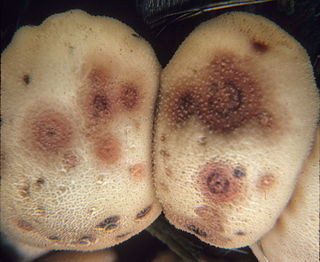
Stachybotrys is a genus of molds, hyphomycetes or asexually reproducing, filamentous fungi, now placed in the family Stachybotryaceae. The genus was erected by August Carl Joseph Corda in 1837. Historically, it was considered closely related to the genus Memnoniella, because the spores are produced in slimy heads rather than in dry chains. Recently, the synonymy of the two genera is generally accepted. Most Stachybotrys species inhabit materials rich in cellulose. The genus has a widespread distribution and contained about 50 species in 2008. There are 88 records of Stachybotrys on Species Fungorum, of which 33 species have DNA sequence data in GenBank. Species in the genus are commonly found in soil, plant litter and air and a few species have been found from damp paper, cotton, linen, cellulose-based building materials water-damaged indoor buildings, and air ducts from both aquatic and terrestrial habitats.
Teichospora is a genus of fungi in the family Teichosporaceae.
Microthyrium is a genus of fungi in the Microthyriaceae family.

Apiospora is a genus of fungi which cause plant diseases. It gives its name to the family Apiosporaceae, which contains a number of other genera. This is historically a name for the teleomorph (sexual) life-cycle stage of the fungus; for some species the corresponding anamorph name is Arthrinium.
Phragmocapnias is a genus of fungi in the family Capnodiaceae.
Graphium is a genus of fungi in the family Microascaceae. Historically, Graphium was used for hyphomycetes with erect, black synnemata bearing a single, terminal, ball of one-celled, hyaline conidia produced from annellides. More than 100 species were described following that general concept before the diversity of sexual states and DNA phylogenies led to reclassification of most species. The approximately 20 species remaining in the modern genus are assumed to be minor plant pathogens on trees. Most species reported in soil, plant debris, woody substrates, manure, and polluted water are now classified in other genera such as Parascedosporium or Ophiostoma.

Pestalotiopsis is a genus of ascomycete fungi in the Sporocadaceae family.

Monochaetia is a genus of fungi in the family Sporocadaceae. Species in the genus are typically plant parasites and saprobes, and cause leaf spot diseases on various hosts.
Seimatosporium is a fungus genus within the family Sporocadaceae.

The Coniochaeta are a genus of pleomorphic yeasts of the order Coniochaetales and are pathogens of trees. Some species have also been found to form endophytic associations within plants in which they live inside plant tissues but do not actually harm the organism. They can take the form of pink to brown colonies, hyphae, conidiophores or sclerotia. In 2013, the Lecythophora were merged with the Coniochaeta, following suggestions by Ziauddin Khan et al.

Passalora is a genus of fungi in the family Mycosphaerellaceae. It has about 250 species.

Epicoccum is a genus of fungi belonging to the family Didymellaceae.

The Sporocadaceae are a family of fungi, that was formerly in the order Xylariales. It was placed in the Amphisphaeriales order in 2020.








